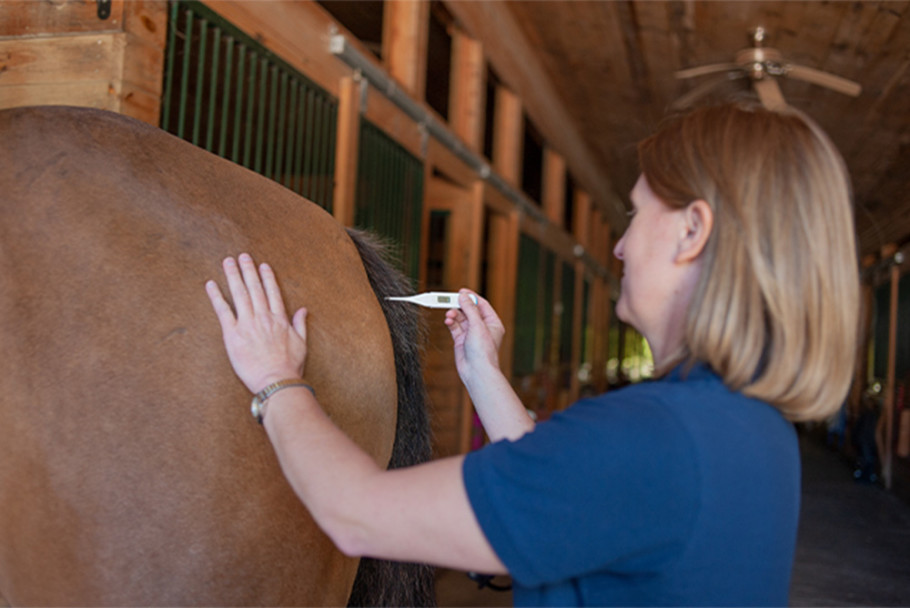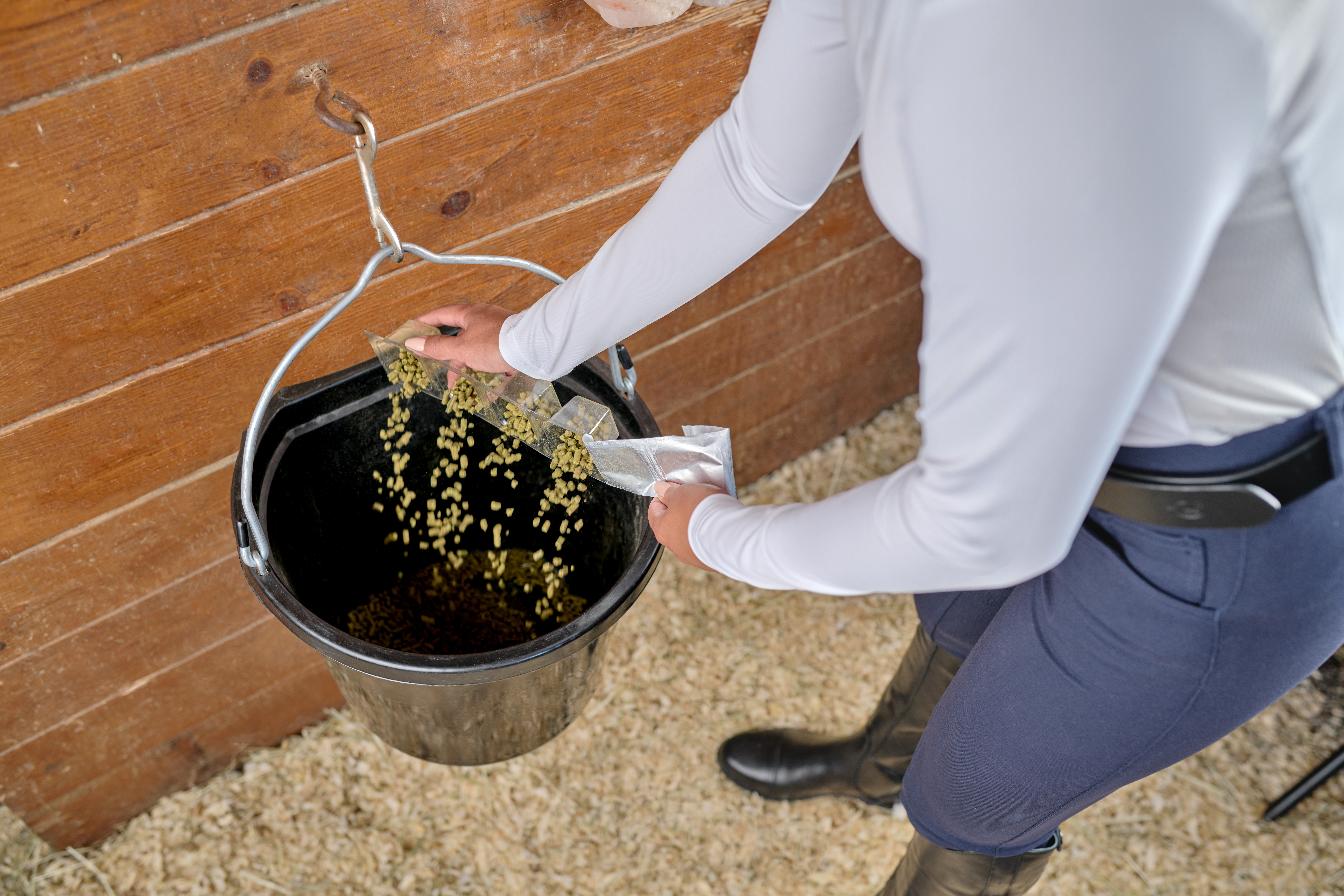Leaky Gut Syndrome in Horses
By: Dr. Lydia Gray | Updated March 23, 2025 by SmartPak Equine

As experts learn more and more about the structure and function of the gastrointestinal tract, especially in horses, it’s clear that it plays a much larger role in overall health and wellbeing than just digesting and absorbing food.
For example, nearly 70 percent of the body’s total immune system is found in the gut. In addition, the intestinal lining itself serves as a barrier to agents that could cause disease and illness if allowed to pass through. This article will explain what leaky gut syndrome is and why it matters, what causes a “leaky gut” in horses, and what can be done about it.
What is Leaky Gut Syndrome (LGS)?
The primary task of the equine GI system is to break down food into smaller particles (digestion) that can be taken across the intestinal wall (absorption) and into the bloodstream to be distributed throughout the body. All the nutrients that horses eat – vitamins, minerals, protein, fats, carbohydrates – need to get across the lining of the small or large intestine to be used.
But horses also ingest a lot of other things besides nutrients, some of which could cause disease or illness if they got into the bloodstream. This includes toxins normally present in the environment, food allergens, and microorganisms such as E. coli, Salmonella, and Clostridium species. Therefore, another important job the gut performs is blocking harmful agents from making their way inside of the body.
This is where the concepts of intestinal permeability and leaky gut come in. When something is permeable, it means it allows substances to pass through it. The intestinal lining can’t be completely permeable, or it wouldn’t be doing its job of protecting the body from harmful substances. If it was, the entire body would be exposed to everything – good and bad – that ever got into the digestive tract.
However, when the equine intestinal lining is damaged or weakened, the gut becomes more permeable than normal (“leaky”) and allows things to cross that normally wouldn’t be able to.

Protective Layers and Intestinal Permeability
Scientists have discovered there are four levels of protection making up the defensive barrier of the intestinal lining to separate the digestive tract from the bloodstream and the rest of the body. There is a layer of:
- Mucus
- Beneficial bacteria
- The immune system found in the gut
- Intestinal cells linked by “tight junctions”
Each of the layers work together to allow necessary substances (such as nutrients) to pass through.
Unnecessary or harmful substances are normally blocked from passage. When any of these protective layers are disturbed, the intestinal permeability is altered and Leaky Gut Syndrome or LGS may occur. Depending on the type and extent of damage to intestinal cells, “leaks” may occur at the paracellular level (that is, between two cells) or the transcellular level (through one cell).
Signs of a Leaky Gut in Horses

When the gut begins to “leak,” or become more permeable than normal, there is both local, intestinal damage as well as systemic, body-wide damage. Think of it like a bug bite: the immediate skin becomes inflamed (red, swollen, painful) but other organ systems and even the entire body may be affected if the insect carried a disease.
In the case of Leaky Gut Syndrome in horses, there may be signs directly related to injured and inflamed intestinal tissue such as recurrent, low-grade colic; loose stool or Free Fecal Water Syndrome; and weight loss, among others.
There may also be signs related to other organs and systems affected by harmful foreign material that made it into the general circulation. Joint inflammation, skin allergies, pneumonia (lung infection), laminitis, endotoxemia, and autoimmune disease are just a few examples.
These are some of the more severe outcomes of a leaky gut. Sometimes though, horses with this condition can just seem “off.” Maybe they’re not performing at their usual level or have a change in personality or behavior and become either dull and lethargic or cranky and irritable. It may be as simple as lack of appetite.
Whether LGS leads to a horse basically not feeling well or to more serious, even life-threatening disease, it’s important to work with a veterinarian to figure out why the horse is ill and treat the underlying cause.
Common Causes of Leaky Gut Syndrome

There are many different reasons or triggers, for why a horse may develop a leaky or permeable gut. In addition, one trigger may impact another, such as a change in hay may lead to an imbalance between the populations of good and bad bugs in the hindgut, known as dysbiosis. Similarly, a trigger such as colic can be both the cause and the result of a leaky gut.
This list contains categories and examples of common stressors that can trigger the gut to “leak.”
- Diet: abrupt changes in hay or grain, mold toxins, feed or water restrictions
- Environment: excessive heat, dramatic weather changes, insects, social stress
- Performance: training, competitions, injuries
- Medications: non-steroidal anti-inflammatories (NSAIDs), antibiotics
- Situations: trailering, vet and farrier visits, schedule changes, excessive stall time
- Metabolic: obesity
- Health: infections (bacterial, viral, protozoal, fungal), parasites, local or whole body inflammation, colic, dysbiosis
Some triggers can be severe enough that one incidence breaks down the protective intestinal barrier (“breaches the hull”). On the other hand, minor damage from other triggers might cause a slow drip that, over time and repeated exposures, finally compromises the integrity of the cells, tight junctions, and other defensive components.
How is LGS Related to Dysbiosis and the Gut Microbiome?
Some articles use the terms Leaky Gut Syndrome and dysbiosis interchangeably, but they do mean different things:
- Leaky Gut Syndrome is the condition where the barrier function of the bowel is disrupted and harmful substances pass through the intestinal lining into the bloodstream (where they can now access the entire body through the circulation)
- Dysbiosis is an imbalance between the good and bad “bugs” present in the body’s natural microflora, especially in the gut. It can contribute to the development of Leaky Gut Syndrome.
Likewise, it is becoming common to use the term “microbiome” when actually “microbiota” is more correct (although even scholars are softening to this rule):
- Microbiome specifically refers to the genetic material of all the microbes – bacteria, fungi, protozoa, and viruses – that live on or inside the body. It comes from combining the words “microorganism” and “genome.”
- Microbiota is actually the correct term to use when referring to the microorganisms themselves, the bacteria, fungi, protozoa, and viruses normally found in a particular site, such as the intestinal tract.
However, for the purpose of this and other articles, SmartPak will use microbiome when talking about the microorganisms themselves.
Treatment, Management, and Nutrition

Work with Your Veterinarian to Diagnose the Issue
Because of the wide variety of clinical signs associated with LGS – everything from GI issues like colic and diarrhea to laminitis, allergies, infections, and more – it’s essential to involve a veterinarian at the first indication that something isn’t right with a horse. Physical examination and diagnostic testing may point to an issue that can be resolved with appropriate treatment and management.
That’s step one: work with a vet to identify and remove the cause of the horse’s current ill health whether due to infection, parasites, poor-quality diet, pain or stress, etc. While there are specialized tests to determine if the gut has become leaky, they are not commonly performed.
Get the GI Tract Back in Good Health
The second step is to restore the GI tract back to health. Whether the problem started in the gut or not, the horse’s poor health, lack of appetite, or even medical treatment likely altered the intestinal environment enough so that neither the protective lining nor the beneficial “bugs” are functioning properly.
It will take good management practices, a well-constructed diet, and thoughtful support to repair, rebuild, and strengthen a gut that has become leaky. Good management includes abundant turnout, plenty of social time, and a sensible exercise, travel, and competition schedule.
Nutrition and Supplements to Support Digestive Health

The diet should be built around long-stem forage, only providing grain if additional calories are needed. Otherwise, the nutrients found in ration balancers or multi-vitamin/mineral supplements may be enough to complete and balance the diet.
For horses that are being subjected to stress, i.e., a heavy workload, showing, trailering, frequent or abrupt changes in hay or grain, excess stall time, it may be a good idea to take a proactive approach to digestive health. In addition, even the best feedstuffs should be inspected on a regular basis to ensure they’re of a quality that supports intestinal health.
Supplemental support for the equine digestive tract comes in many shapes and sizes:
- Probiotics and Prebiotics
- Yeast and yeast metabolites
- Enzymes
- The amino acid glutamine
- Omega 3 fatty acids
- Antioxidants
Short-chain fatty acids or SCFAs (a subset of volatile fatty acids or VFAs) are another category of digestive support. Normally produced by microbes in the gut for use locally and throughout the body, an unhealthy gut results in lower levels of these, just when more are needed.
One such SCFA, butyric acid, is recognized as the preferred energy source for the cells that line the intestinal tract and is therefore vital to their growth, development, and function. While butyric acid is a natural product of bacterial fermentation in the horse’s hindgut, there are times when providing additional levels in the feed can be helpful.
When combined with the mineral zinc – known to play a role in the mucosal repair process – the body has what it needs to preserve the natural protective barrier of the intestinal lining, strengthen tight junctions, and contribute to the health and integrity of the gut.
Summary
The horse’s intestinal tract does more than just digest and absorb food; it has a prominent role in making sure the entire body stays healthy. In order to serve as a barrier against agents of disease and inflammation however, the gut itself must be in good health. A leaky gut that is permeable to harmful organisms and other substances can be triggered by a wide range of stressors and situations.
Fortunately, proven equine management strategies, a high-quality diet, and digestive support – in addition to good veterinary care – go a long way toward maintaining gastrointestinal health.
Evidence-Based Resources for Horse Owners
- Stewart, Amy Stieler, et al. “Alterations in Intestinal Permeability: The Role of the ‘Leaky Gut’ in Health and Disease.” Journal of Equine Veterinary Science, vol. 52, May 2017, pp. 10–22. https://doi.org/10.1016/j.jevs.2017.02.009.
- McGilloway, Melissa, et al. “The Combination of Trailer Transport and Exercise Increases Gastrointestinal Permeability and Markers of Systemic Inflammation in Horses.” Equine Veterinary Journal, vol. 55, no. 5, Nov. 2022, pp. 853–61. https://doi.org/10.1111/evj.13888.